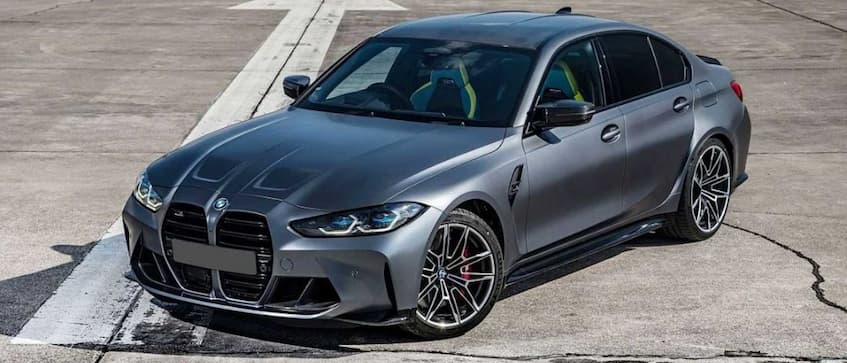
3 Suggested Mods the BMW M3
Since its debut in 1986, the BMW M3 has become the iconic touring car among automotive enthusiasts. The first E30, powered by a high-revving naturally-aspirated 4-pot with 200 horsepower, obliterated everything in its field, going on to win the European Touring Car Championship, the Spa 24 Hours, and 4 consecutive wins in the 24 Hours of Nurburgring.
BMW soon moved on to in-line 6 and V8 engines, equipped them with turbochargers, and introduced in-house tuning with the Competition models. The current versions feature over 500 horsepower, unmatched driving dynamics, and the practicality to put many family sedans to shame.
The car also shines with its tuning potential. Custom builds with 1000+hp aren’t uncommon, and are achieved with relatively simple additions, including a BMW M3 aftermarket exhaust, revised cold intakes and an ECU to balance power delivery. The upgrades free up airflow in and out of the engine, and optimise the fuelling, ignition, and boost pressure.
Contents
Why Consider an Aftermarket Exhaust for Your M3?

Even performance cars are subjected to noise and emissions regulations, meaning restrictive designs that curb overall engine output. The S65 V8, the turbocharged S55 and the S58 can produce more power than the road-legal versions with an aftermarket exhaust. With fewer bends, wider piping, innovative muffler designs and a superior overall build, these bring a longer list of benefits:
- Increased power and torque: No engine in the M3 is lacking in terms of power, but why not have more? The straighter, wider piping in aftermarket exhausts frees up airflow from the manifold to the tips, reducing instances of backpressure and other restrictions to ease spent gases out faster and let the engine breathe. The improved engine efficiency brings an additional 3 to 5 per cent of rated power, or 15 to 25 more horses to play with. Torque is also increased, meaning more pulling power from a standstill.
- Faster turbo spooling: For the turbocharged engines, expect faster spooling and improved turbo response with new downpipes and catalytic converters.
- Deeper, raspier, louder sound: Faster-moving combustion gases in higher volumes produce a deeper and louder exhaust note. This pairs well with the newfound power on tap and is part of the driving pleasure a new exhaust provides. Consider proprietary technologies, such as valving to tune the exhaust sound to your taste.
- Durability: High-grade (304) stainless steel improves strength, corrosion and heat-resistance over factory units, and is more capable of handling the high temperatures and pressures that come with tuning and power additions. Move on to titanium and Inconel for piping uniformity at extreme engine loads, and carbon fibre tips for unrivalled corrosion resistance.
- Weight savings: Materials used in aftermarket systems not only warrant an exhaust that will outlast the car, but also come with considerably lower weight. Expect to shave off up to 20 kilos from the factory system in a full, turbo-back BMW M3 aftermarket exhaust.
- Aesthetics: Black power-coated, polished chrome and carbon fibre parts add to the whole race-ready aesthetic of the car. Design specifics, such as quad outlets, hot-dog resonators and horizontally-positioned mufflers, also spice things up with improved visual appeal.
Pair Exhausts with Cold Air Intakes
Cold air intakes are the perfect power pairing when increasing performance in your M3. With larger, oiled cone-shaped filters slotted in high-flow airboxes, relocated piping in wider diameters to draw more oxygen-rich air and additions like aluminium heat shields to prevent heat soak from hot engine parts, this is the performance equivalent of an aftermarket exhaust fitted at the intake end.
Cold air intakes increase the volume and velocity of oxygen-rich air entering the engine. As such, they boost engine efficiency with improved combustion, meaning more usable torque and power. This urges the M3 to higher top speeds, with faster 0-100 times and improved lap records if you’re doing track duty. The engine is more responsive to throttle input, belts out a distinct intake growl, and, with better builds and quality materials in the intake, also looks the part.
Balance Power Output with an ECU Tune
Aftermarket air intakes and exhausts alter the factory settings or software maps in the ECU that control parameters such as the fuel and boost pressure when working the throttle. This can lead to performance and reliability issues, such as sluggish acceleration or abnormally high fuel use.
ECU tunes catering to Stage 2 additions like exhausts and intakes, balance air-fuel ratios. Increased intake and exhaust air volumes are paired with higher fuel pressure for smooth throttle response. An ECU tune also calibrates turbo spooling for linear acceleration. This leads to consistent performance without any of the reliability issues.
Remapping the ECU also helps with other performance factors, such as deleting the factory speed-limiter in the M3 (limited to 250km/h) and letting the car reach 300km/h. There’s also changing the pre-mapped power band and how torque comes in, with higher redlines at the top end or more pulling power down low. Either way, these three affordable additions make an already capable performance machine even more fun to drive.


Sorry, the comment form is closed at this time.